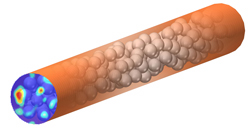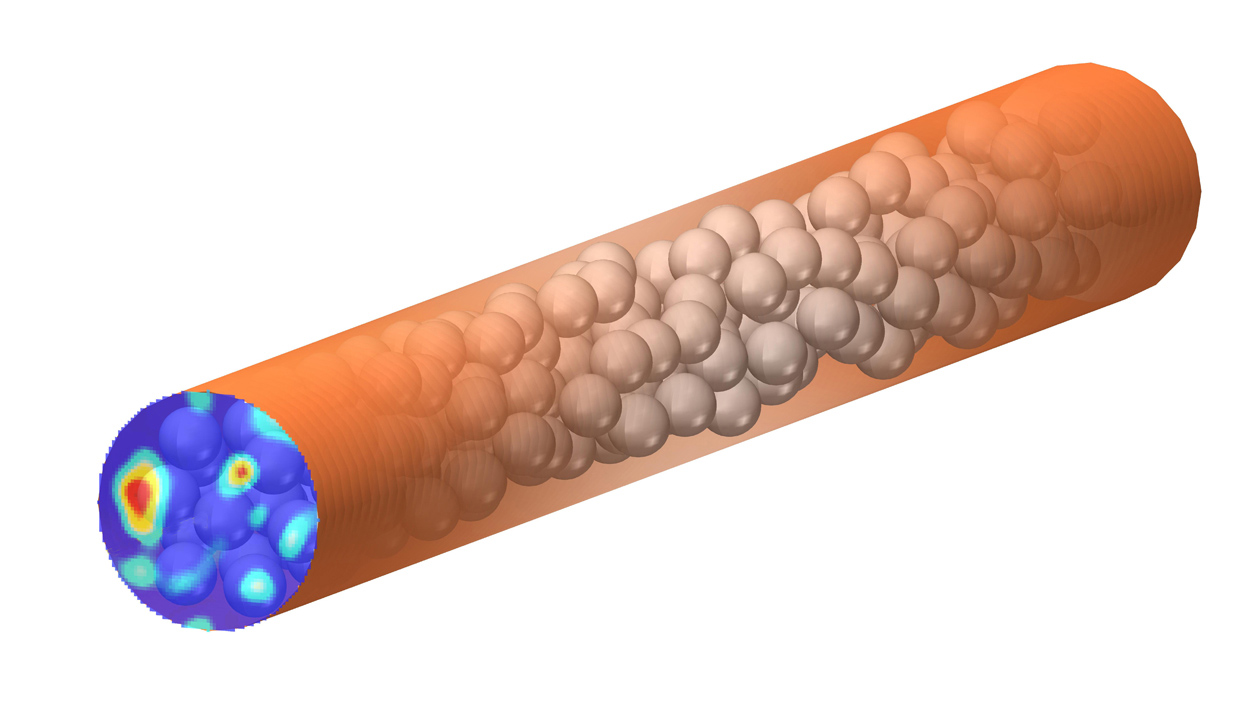Hidden Wave Behavior Revealed
Use your cell phone in a remote forest and you might notice that your signal fades in and out, as radio waves bounce off intervening objects and add to or cancel each other. In the 10 August Physical Review Letters, researchers study how the fadeouts change as they modify the waves in a related laboratory model–microwaves hitting a tube filled with Styrofoam-spaced metal spheres. The results could help researchers in geology, engineering, and medicine learn about the internal makeup of materials and tissues by studying the so-called speckle pattern in waves that pass through them.
Imagine a tube haphazardly packed with pebbles, and your goal is to learn about them by sending in electromagnetic waves. X rays would pass straight through to form a simple shadow. But microwaves would bounce around many times, scrambling the internal information as they diffuse through the sample before emerging. This diffusive scattering is one way for waves to interact with such particles. But if the particles scatter strongly enough and the wave frequency is within a special range of frequencies, a strange phenomenon occurs: the waves can become “localized” in particular regions–“hot spots” of electromagnetic energy can appear in some of the spaces between particles. Surprisingly, however, researchers have found no simple way to identify this condition.
Azriel Genack of Queens College and his colleagues suspected there was a connection between localization and the way in which the speckle pattern of emerging waves changes with frequency. Some researchers have used complex statistical analyses of speckle patterns, but Genack thought it should be much easier. “This is something you can do–just look and see if the speckle pattern changes smoothly or abruptly” as the wave frequency is increased. To test this approach, Genack’s team took several hundred blueberry-sized Styrofoam balls and laboriously stuffed each one with a tiny ball of alumina, a material that is ideal for scattering microwaves. Then they dumped the balls into a copper tube. They shined microwaves in one end and mapped the speckle patterns that appeared at the other end.
As the team gradually increased the microwave frequency, the speckle pattern’s dark spots moved around smoothly. But suddenly, in frequency ranges where the waves became localized, the dark spots began moving erratically–remaining in each arrangement briefly before jumping to the next arrangement. Each jump signified that the system had found a new special frequency for localization. As they raised the frequency still higher, above the localization range, the dark spots began moving smoothly again. Even though the localized and diffusive patterns evolved differently, the team found a common statistical language to describe them both. “It fits so beautifully,” says Genack. “It’s a bit of a mystery as to why this formula works.”
Genack sees applications of the speckle technique for surveying of geological formations and ice caps, as well as inspecting aerospace components. But even in systems that are not likely to demonstrate localization–like the human body–the statistical analysis of speckle could be valuable. Diederik Wiersma of the University of Florence in Italy sees an application to locate tumors with speckle patterns made by transmitting light through breast tissue. “There is a whole community trying to do medical imaging with diffuse light,” says Wiersma. “This is a very serious application.”
–Mike Wofsey





